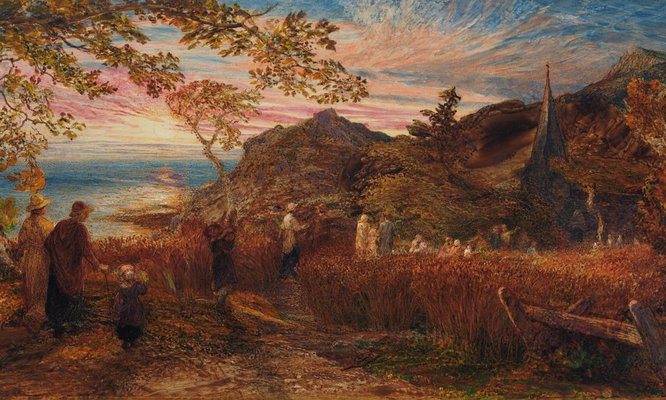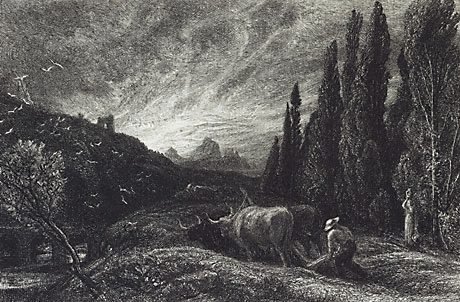-
Details
- Other Title
- Old England's Sunday Evening
- Date
- 1874
- Media category
- Watercolour
- Materials used
- watercolour and bodycolour with gum and scraping out over pencil underdrawing
- Dimensions
- 31.4 x 70.7 x 0.1 cm board; 59.0 x 97.0 x 6.0 cm frame
- Signature & date
Signed l.l., watercolour "SAMUEL PALMER". Not dated.
- Credit
- Parramore Purchase Fund, with additional funds provided by the Mollie and Jim Gowing Bequest, John Schaeffer Fund, European Art Collection Benefactors Fund and the Art Gallery Society of NSW 2023
- Location
- South Building, ground level, Grand Courts
- Accession number
- 305.2023
- Copyright
- Artist information
-
Samuel Palmer
Works in the collection
- Share
-
-
About
'Going to evening church' is a tour-de-force of Palmer’s last period (c1865–81), a time of growing critical success after decades of neglect, and it is typical of the meditative mood seen in the pictures of his later years. During this phase, Palmer produced a series of technically elaborate and compositionally complete watercolours in a larger than usual format, notable for their emphatic treatment of light and colour, and their beautifully rendered skies. This picture is particularly rich in painterly effects, with passages both of thin watercolour washes and dense layers of bodycolour and gum. Palmer’s complex technique is as personal as his style.
'Going to evening church' ranks among the artist’s greatest achievements since the youthful works done in the Kentish countryside at Shoreham in the 1820s and early 1830s. Palmer evidently held the picture in high regard as he selected it as his sole entry for the Old Watercolour Society exhibition in 1874. The critic of 'The Athenaeum', F.G. Stephens praised its ‘deep poetic suggestiveness,’ and claimed it exemplified ‘the skill and genius of this painter of the Dorian mood’, relating the picture’s pensive character and haunting lyricism to the severe Greek Dorian mode of music.
'Going to evening church' is an imaginative vision – a synthesis of imagery that had shaped Palmer’s life, including scenery from Kent, Devon, Wales and Italy. It shows a long vista down a hillside into a calm sea beneath a glorious sunset ablaze with pink, vermilion, yellow and purple. In the left foreground a small group gathers beneath the arching trees. Branches and figures conspire to frame the far-off view and setting sun in a perfectly circular window, as if enacting the psychic interconnectedness of all living things. It is significant that among the figures are small children and a baby. For like Wordsworth and Blake, Palmer believed children were proto-typical Romantics and life-forces of nature, uncorrupted by experience and still close to eternity.
On the other side of the composition, the edge of a heavily laden cornfield leads our eye into the middle distance where a procession of country folk – intimately associated in pastoral art with the natural world and its celebration – meanders its way towards a little church nestled in the trees. ‘Churches’, wrote Palmer, ‘are the most charming points of an English landscape – gems of sentiment’, and they featured in many of the artist’s early works. Perhaps symbols of divine providence, they are also reminders of Palmer’s religious convictions as a devout Anglican at a time of declining faith in the wake of Darwinism.
Palmer was inspired with a fervour that was as much transcendental as it was applicable to the terrestrial circumstances of the Victorian age, with its rampant industrialization and destructive human activity. He would counteract the social and spiritual shortcomings of his materialistic, utilitarian society with a celebration – expressed with the most tender feeling – of the stimuli which the natural world provides, and his belief that we are all part of the same family as the nature around us.
‘Landscape of any kind’, Palmer wrote, ‘is poor work without its persons, politics and human associations – expressed or understood.’ 'Going to evening church' is centrally about human experience and the benign and inspirational role of nature in relation to humanity. Into its gentle contours Palmer inscribed a lifetime’s enriched perceptions of what was profound and enduring in human life, fashioning a timeless vision of abundance and idyllic peace – a distillation of the earthly paradise.
-
Exhibition history
Shown in 2 exhibitions
Exhibition of the Society of Painters in Water Colours. The Seventieth., Society of Painters in Water Colours (SPWC), London, Apr 1874–Apr 1874
Samuel Palmer 1805 –1881, an exhibition of paintings, drawings and etchings, Graves Art Gallery, Sheffield, 1961–1961
-
Bibliography
Referenced in 6 publications
-
Henry Gerrish, Samuel Palmer. Going to Evening Church, London.
-
Raymond Lister, Catalogue raisonné of the works of Samuel Palmer, 1988, p 208, no 669, illus p 208.
-
Stephen Romei (Editor), Look, 'International artwork acquisition', Sydney, Feb 2024-Mar 2024, p 12, col illus p 12.
-
F G Stephens, The Athenaeum, no 2426, ‘Fine Arts – The Society of Painters in Water Colours’, London, 25 Apr 1874, pp 565–67: p 567.
-
Samuel Palmer 1805 –1881, an exhibition of paintings, drawings and etchings, Sheffield, 1961, page tbc, no 72.
-
Exhibition of the Society of Painters in Water Colours – Catalogue [The Seventieth], London, 1874, p 8, no 91. as 'Old England's Sunday Evening'.
-





